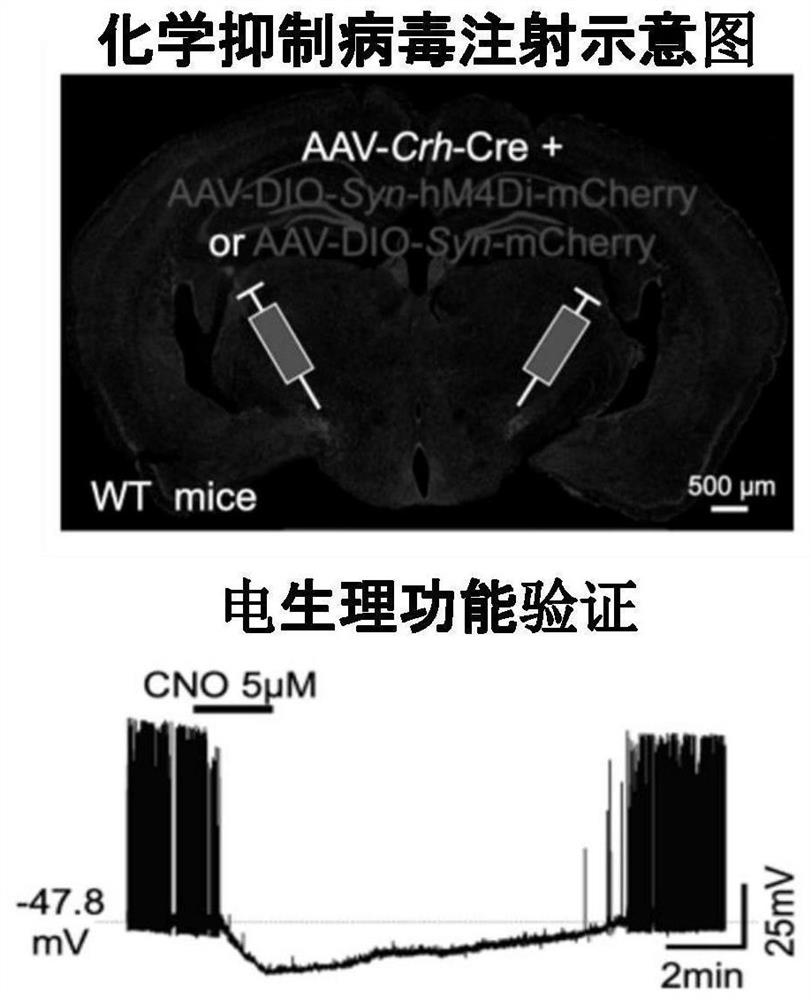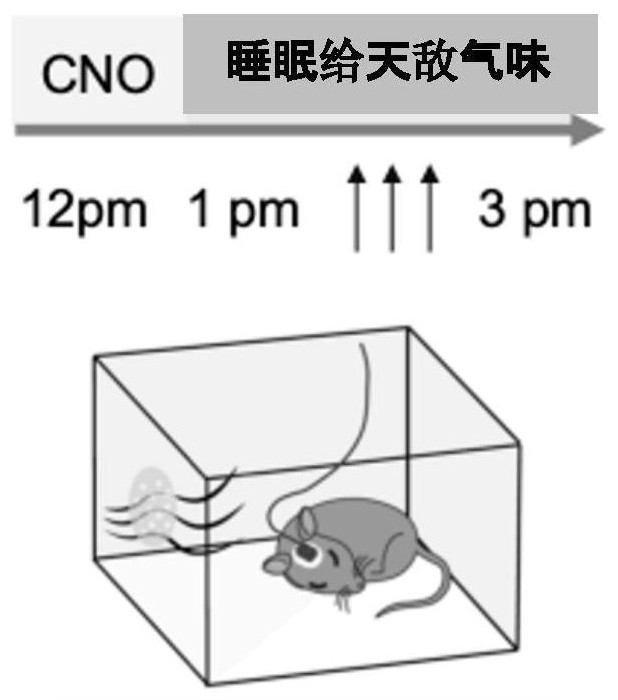Antagonist composition and application thereof in preparation of medicine for treating sleep disorder and mental disease
A technology for mental diseases and sleep disorders, applied in the field of biomedicine, can solve the problems of uncontrollable side effects, inability to act locally, and unknown scope of action, and achieve the effect of improving sleep disorders.
- Summary
- Abstract
- Description
- Claims
- Application Information
AI Technical Summary
Problems solved by technology
Method used
Image
Examples
Embodiment 1
[0066] Exploring the regulatory role of CRH neurons in the subthalamic nucleus on REM sleep and fear responses
[0067] This example explores the regulatory effect of CRH neurons in the subthalamic nucleus on REM sleep and fear response.
[0068] Firstly, AAV9-Crh-Cre and AAV9-DIO-Syn-hM4Di-mCherry (experimental group) were expressed in the subthalamic nucleus of the subject (C57BL6J wild-type mice) through stereotaxic brain region and micro-injection of virus (experimental group). A total of 75 nanoliters were injected after mixing the substance ratio of 1:1); or AAV9-Crh-Cre and AAV9-DIO-Syn-mCherry (control group) (after mixing the two at a substance ratio of 1:1 A total of 75 nL was injected). Wherein AAV9-Crh-cre is used to express the Cre enzyme in the neurons expressing CRH in the subject, wherein the CRH promoter sequence was reported by J Chen et al. in 2012 (see for details figure 1 ). The sequence of AAV9-DIO-Syn-hM4Di-mCherry and AAV9-DIO-Syn-mCherry contains a ...
Embodiment 2
[0073] Exploring the overlap between CRH neurons and glutamatergic neurons in the subthalamic nucleus
[0074] After the present invention confirms the regulating effect of the CRH neurons of the subthalamic nucleus on REM sleep and fear response through Example 1, the CRH neuron types of the subthalamic nucleus are further analyzed. This example explores the overlap between CRH neurons and glutamatergic neurons in the subthalamic nucleus.
[0075] By injecting AAV-DIO-EYFP virus (injection 75 nanoliters) into the subthalamic nucleus ( Figure 3A ), to infect glutamatergic neurons in the subthalamic nucleus, and it was observed that the subthalamic nucleus expresses a large number of glutamatergic neurons. In situ hybridization staining was used to judge whether the expression of endogenous glutamic acid RNA was co-labeled with the viral expression EYFP to verify the specificity of the VGLUT2-cre mice used. Statistical results such as Figure 3B As shown, it can be seen tha...
Embodiment 3
[0081] Exploring the effects of CRH receptor antagonists on sleep and fear response
[0082] This example explores the effects of administering CRH receptor antagonists on sleep and fear responses.
[0083] The CRH antagonist group was used as the experimental group, and the DMSO solvent group was used as the control group. The CRH antagonist is selected from CP154526, which can bind to CRH receptor type 1, thereby competitively blocking the binding of CRH transmitters. Inject 75 nanoliters of a mixture of AAV-DIO-EF1a-ChR2-mCherry and AAV-Crh-cre (mass ratio 1:1) in the subthalamic nucleus of the subject (C57BL6J wild-type mice) The ChR2 light-activated protein was expressed in the CRH neurons, and after 4 weeks of virus expression, an optical fiber was implanted in the subthalamic nucleus to deliver blue light, so that the blue light stimulated the ChR2 protein to activate the CRH neurons in the subthalamic nucleus, and administered the protein to the lateral globus pallidu...
PUM
 Login to View More
Login to View More Abstract
Description
Claims
Application Information
 Login to View More
Login to View More - R&D
- Intellectual Property
- Life Sciences
- Materials
- Tech Scout
- Unparalleled Data Quality
- Higher Quality Content
- 60% Fewer Hallucinations
Browse by: Latest US Patents, China's latest patents, Technical Efficacy Thesaurus, Application Domain, Technology Topic, Popular Technical Reports.
© 2025 PatSnap. All rights reserved.Legal|Privacy policy|Modern Slavery Act Transparency Statement|Sitemap|About US| Contact US: help@patsnap.com



